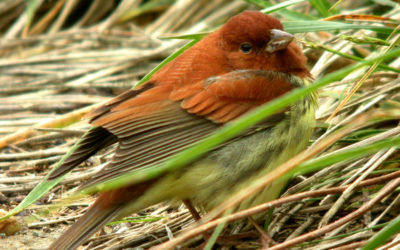Bird News from Nial Moores (with Mark Harris 22nd-25th and Ju Yong-Ki 31st).
A total of 151 species recorded to date, with a good spread of what are generally considered to be irruptive species in the ROK (including Chinese Nuthatch, Eurasian Treecreeper, Common Redpoll and Eurasian Bullfinch) though with still no Oriental Storks (a major focus of the current research), and no exceptional numbers or movements of more abundant species – despite some interesting weather.
- Tundra Bean Goose Anser serrirostris. Increasing steadily, with 950 counted on the 29th.
- Stejneger’s Scoter Melanitta stejnegeri. At least 161 were present on the 22nd.
- Merganser sp. Three female mergansers showing multiple features suggesting Scaly-sided Merganser flew west in strong winds and rain on the 25th. However, views were insufficient to make a confident identification.
- Japanese Quail Coturnix japonica. NT. The only record was of two on 29th.
- Eurasian Spoonbill Platalea leucorodia. Five were seen on 22nd, with one remaining until at least the 29th.

- Chinese Pond Heron Ardeola bacchus. One on 30th. Although regular in spring, this is my first record in autumn on the island.
- Chinese Egret Egretta eulophotes. VU. One was present on the Jincheon tidal flat at least until the 26th.

- Greater Spotted Eagle Clanga clanga. VU. Two on 22nd (one of which was relentlessly harassed by two Large-billed Crows); one on 26th; and one on 31st. All have been juveniles.




- Hen Harrier Circus cyaneus. One in Jincheon on 30th and one in Junghwadong on 31st.

- Pied Harrier Circus melanoleucos. One on the 23rd.
- Upland Buzzard Buteo hemilasius. First was one on 29th.
- Water Rail sp. One was seen in flight and heard briefly in Yeonhwari on 23rd, and one was heard in Jincheon on 29th.
- Little Owl Athene noctua plumipes. One or two have been heard calling most nights; with one seen in the late evening on 28th.
- Chinese Grey Shrike Lanius sphenocercus. Although 1-2 are regular on the island in October, this year there have been up to five present, with at least 2-3 still present in territory on 29th-30th.
- Japanese Waxwing Bombycilla japonica. NT. An extremely scruffy individual was poorly photographed on 30th.

- Light-vented Bulbul Pycnonotus sinensis. The highest day count has been 230 on the 23rd (with flocks in multiple areas, including c. 175 in Junghwadong), with probably 300-500 present on the island in total.
- Japanese Bush Warbler Horornis diphone. One was heard on 22nd. My first on this island.
- Long-tailed Tit Aegithalos caudatus. Apparently a decent irruption of this species is ongoing, with the highest day count so far 60 on the 22nd.


- Chestnut-flanked White-eye Zosterops erythopleurus. Present on the island until the very end of the month in small numbers.

- Swinhoe’s White-eye Zosterops simplex. One seen on 22nd, in the same area as the previous week. A group of c12 white-eyes seen poorly and heard in Dumujin on 27th were thought most likely to be this species.
- Chinese Nuthatch Sitta villosa. Three singles were logged on the 22nd.
- Eurasian Treecreeper Certhia familiaris. One was heard on 24th.
- Red-throated Thrush Turdus ruficollis. An adult male type was seen briefly in good light on 27th.
- Naumann’s Thrush Turdus naumanni. One on 23rd, and then daily from 27th with an estimated 110 on 28th.



- Dusky Thrush Turdus eunomus. Small flocks note almost daily from the 22nd, with an estimated 250 on 28th.
- Bluethroat Luscinia svecica. Singles on 23rd and 29th.
- Alpine Accentor Prunella collaris. Six were on the “regular rocks” on 25th.

- Olive-backed Pipit Anthus hodgsoni. Disappointingly small numbers (considering the estimated 1,000 on 27th October 2016), with the highest day count only 54 on 27th.

- Eurasian Bullfinch Pyrrhula pyrrhula. One on 28th, at least 18 west on the 30th, and a dozen or so west on the 31st.
- Common Redpoll Acanthis flammea. Three redpoll were heard and seen in flight on 27th. One showed an obviously paler rump band suggesting Arctic.
- Red Crossbill Loxia curvirostra. Small numbers present on several dates, with the highest count 75 on the 27th.
- Pine Bunting Emberiza leucocephalos. Only two recorded during this period: singles on 22nd and 27th.
- Yellow-breasted Bunting Emberiza aureola. CR. Two on 27th was the only certain sighting.





